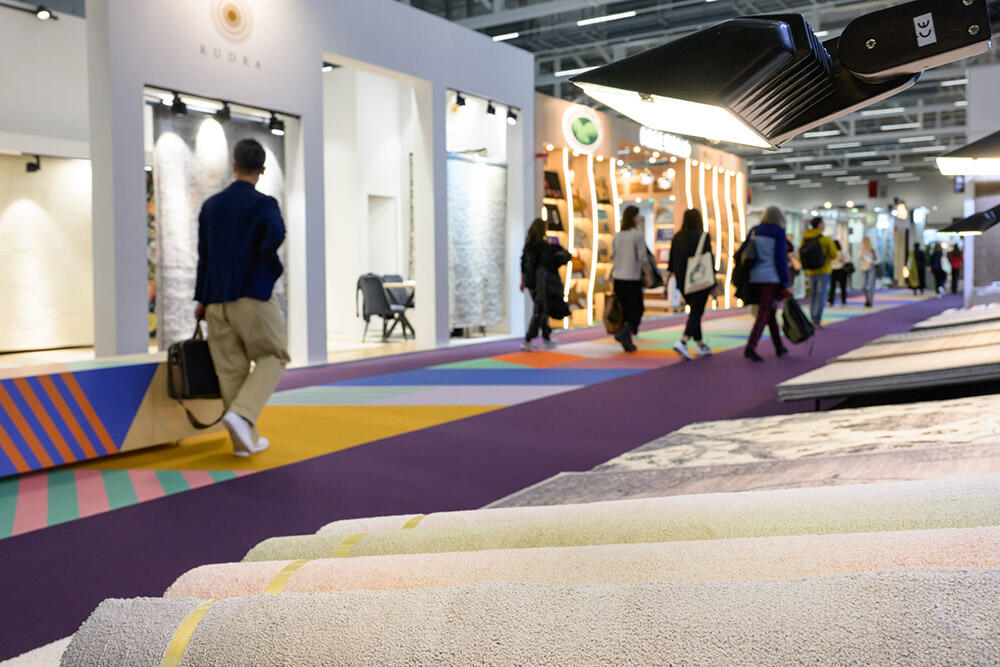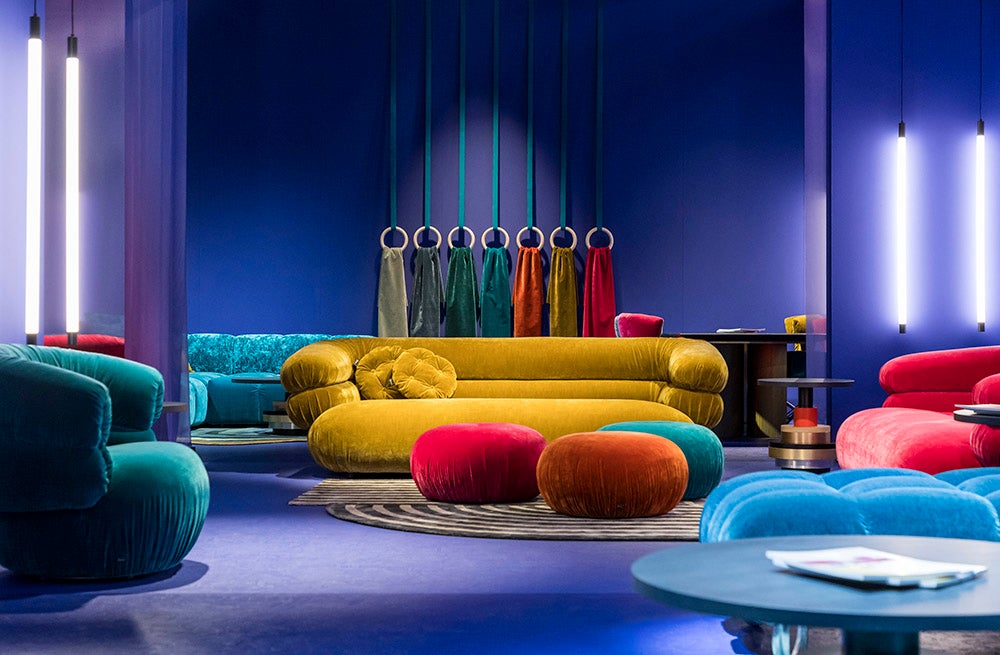When it comes to European trade shows, it’s the best of times, it’s the worst of times. Earlier this month, the behemoth German furniture fair IMM Cologne shared some shocking news: It was canceling its January 2025 edition, citing the departure of key vendors. The very same week, textile-focused Heimtextil—located in Frankfurt—announced almost the opposite: The exhibitor count for its event, slated for mid-January, had already outpaced last year’s numbers, almost reaching prepandemic levels. What’s going on?
American designers may not be intimately familiar with either fair, and neither piece of news may have caused much of a stir on this side of the Atlantic. But the diverging fates of Heimtextil and IMM Cologne point to an inflection moment in the home industry, both abroad and here in the States.
IMM Cologne doesn’t have an exact counterpart. A little bit Salone del Mobile, a little bit High Point—it’s an enormous fair where furniture manufacturers (mostly German) show off their wares to retail buyers and designers from around the world. Founded in 1949, by 2020 it was attracting an attendee base of 128,000, making it one of the largest trade shows—of any industry—in the world at the time. After two years of Covid cancellation, only 30,000 visitors returned in 2023. A modest jump to 42,000 followed in 2024.
According to a representative from Koelnmesse, the local exhibition center that owns the fair, the warning signs began to flash on next year’s show when a number of high-profile exhibitors pulled out. With tentpole brands not participating, it set off a cascade of cancellations from smaller players, ultimately making the 2025 fair financially nonviable—revelations first reported in the European industry publication Interior Daily.
The culprit, according to the spokesperson, is a floundering German furniture business. No surprise: Europe is suffering from the same postboom slump that the American industry has experienced. Making matters worse, the war in Ukraine has added an overall macroeconomic damper to that country’s economy, and customers just aren’t buying like they were during Covid. As a result, both manufacturers and retail buyers are watching their wallets carefully.
“The furniture industry, particularly in Germany, is facing significant difficulties,” the spokesperson tells Business of Home. “According to the latest VDM figures, overall sales dropped by 9.7 percent in the first half of the year, with upholstered furniture down by 11.2 percent. These declines reflect the pressures brands are experiencing, especially in the German market, making trade show participation harder to justify.”
An industry-wide downturn is obviously to blame, but there are other factors here.
For furniture makers, trade fairs are an order of magnitude more expensive and complex than, say, the maker of decorative vases. The transportation costs are higher. The exhibition spaces are bigger. The merchandise is more expensive and damages are more costly. On top of that, furniture is fundamentally a less trend-driven category than many others in the home world, making a yearly show superfluous for some—especially in the internet age. Add all of that up, and you have a climate where major brands were already looking for a reason to pull back—or pull out entirely—of their yearly trade fair commitments.
Covid, which shut down IMM Cologne twice, was a perfect excuse. It broke the “habit” for vendors and attendees alike, leading to a reassessment—especially for the brands spending tens of thousands to exhibit their wares.
Interestingly, pandemic-era predictions that in-person industry gatherings had suffered a mortal blow have proved shortsighted. Most events, both in Europe and in the U.S., have picked up again—in some cases slightly diminished compared with 2019, but outright cancellations are relatively rare. People still want to meet in person, and the value of getting together IRL is clearly more than simple buying and selling.
What has happened is that major furniture brands, especially in Europe, have looked for ways to get outside of the classic trade show model. A notable trend at last year’s Milan Design Week was the exodus of large exhibitors from Salone in favor of hosting parties, events and activations at their own showrooms in Milan. Citywide events like Copenhagen’s 3 Days of Design are gaining steam. The desire to shake things up has put added pressure on events like IMM Cologne at an already weakened moment.
Heimtextil, a globally oriented textile fair, is a very different event. However, like IMM Cologne, it is still fundamentally a buying-and-selling trade show in the home space, and the pressures of Covid cancellations and the postpandemic home crash have weighed on it as well. Attendance in 2019 was 68,000 attendees, a number that shrank to 40,000 immediately postpandemic (it popped up to 46,000 last year).
However, many of IMM Cologne’s challenges don’t apply to textiles. Fabric is a more trend-driven category than furniture—buyers and editors typically feel obliged to visit the fair even during down times to stay abreast of the latest and greatest (and lock in commitments from mills). Exhibiting is easier as well—it’s typically cheaper to manufacture, transport and display fabrics than it is furniture.

Also, home textiles have had more resilience to the postpandemic crash than home furnishings. It’s not hard to understand why: During Covid, consumers all over the world bought as much furniture as they possibly could, and years of demand jumped forward. The sofas that everyone bought during the pandemic haven’t worn out yet, and customers aren’t sick of them. Textiles—a quicker-to-age, cheaper-to-buy category—never fell off as hard and have rebounded quicker.
Textiles also has a rising star: carpets and rugs. For a variety of reasons, the category has boomed over the past five years (witness the enormous growth of brands like Ruggable, and the millions of venture capital poured into John Foley’s Ernesta). While Heimtextil, like IMM Cologne, has seen vendors depart the show, it more than made up for the loss with the introduction of new vendors, including many from the floorcovering world.
“At the last show we had one hall dedicated to carpets and rugs; for the next edition we are opening three different halls,” says Olaf Schmidt, the vice president of textiles and textile technologies for Messe Frankfurt, Heimtextil’s owner and operator. “More than 200 companies are coming from this segment—it has always been part of the show, but it’s really growing.”
IMM Cologne may well be back next year, stronger than ever. Its organizers say they’re taking 2025 as a hard lesson about how to improve the experience for exhibitors and attendees alike. “Like all fairs, IMM Cologne needs to adapt,” says the Koelnmesse spokesperson. “We’re working on new strategies, not just waiting for the market to recover. Inspired by [Koelnmesse’s contract furniture show] Orgatec, we’re developing a concept with the industry to focus on the European B2B furniture market for a 2026 show, ensuring that we evolve with exhibitors’ needs.”
It’s also possible that Heimtextil will have its own challenges to deal with in the year ahead. But for now, the divergence of these two trade show giants speaks to the complexities of how various parts of the home industry—and their attendant trade fairs—are rebounding from the roller coaster of Covid in different ways, and at different speeds.




























